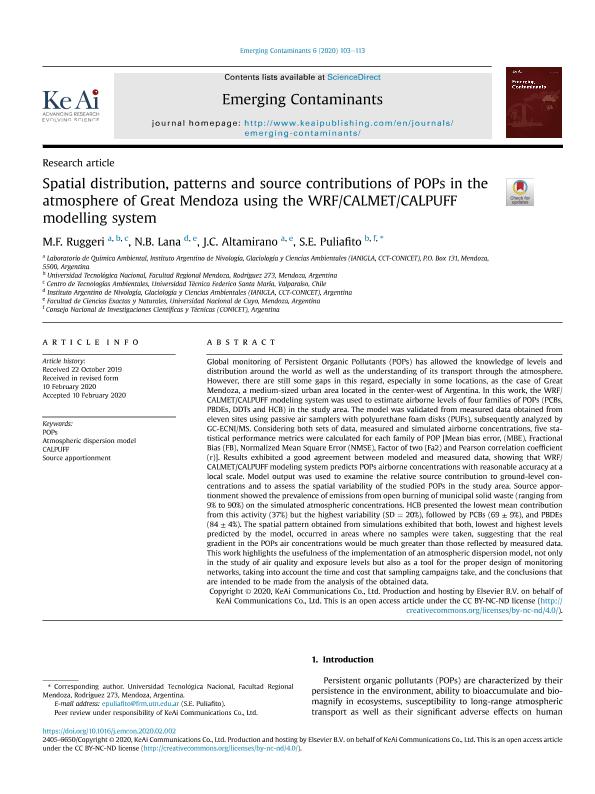Mostrar el registro sencillo del ítem
dc.contributor.author
Ruggeri, María Florencia

dc.contributor.author
Lana, Nerina Belén

dc.contributor.author
Altamirano, Jorgelina Cecilia

dc.contributor.author
Puliafito, Salvador Enrique

dc.date.available
2021-11-16T23:12:00Z
dc.date.issued
2020-01
dc.identifier.citation
Ruggeri, María Florencia; Lana, Nerina Belén; Altamirano, Jorgelina Cecilia; Puliafito, Salvador Enrique; Spatial distribution, patterns and source contributions of POPs in the atmosphere of Great Mendoza using the WRF/CALMET/CALPUFF modelling system; KeAi Communications Co.; Emerging Contaminants; 6; 1-2020; 103-113
dc.identifier.issn
2405-6650
dc.identifier.uri
http://hdl.handle.net/11336/147038
dc.description.abstract
Global monitoring of Persistent Organic Pollutants (POPs) has allowed the knowledge of levels and distribution around the world as well as the understanding of its transport through the atmosphere. However, there are still some gaps in this regard, especially in some locations, as the case of Great Mendoza, a medium-sized urban area located in the center-west of Argentina. In this work, the WRF/CALMET/CALPUFF modeling system was used to estimate airborne levels of four families of POPs (PCBs, PBDEs, DDTs and HCB) in the study area. The model was validated from measured data obtained from eleven sites using passive air samplers with polyurethane foam disks (PUFs), subsequently analyzed by GC-ECNI/MS. Considering both sets of data, measured and simulated airborne concentrations, five statistical performance metrics were calculated for each family of POP [Mean bias error, (MBE), Fractional Bias (FB), Normalized Mean Square Error (NMSE), Factor of two (Fa2) and Pearson correlation coefficient (r)]. Results exhibited a good agreement between modeled and measured data, showing that WRF/CALMET/CALPUFF modeling system predicts POPs airborne concentrations with reasonable accuracy at a local scale. Model output was used to examine the relative source contribution to ground-level concentrations and to assess the spatial variability of the studied POPs in the study area. Source apportionment showed the prevalence of emissions from open burning of municipal solid waste (ranging from 9% to 90%) on the simulated atmospheric concentrations. HCB presented the lowest mean contribution from this activity (37%) but the highest variability (SD = 20%), followed by PCBs (69 ± 9%), and PBDEs (84 ± 4%). The spatial pattern obtained from simulations exhibited that both, lowest and highest levels predicted by the model, occurred in areas where no samples were taken, suggesting that the real gradient in the POPs air concentrations would be much greater than those reflected by measured data. This work highlights the usefulness of the implementation of an atmospheric dispersion model, not only in the study of air quality and exposure levels but also as a tool for the proper design of monitoring networks, taking into account the time and cost that sampling campaigns take, and the conclusions that are intended to be made from the analysis of the obtained data.
dc.format
application/pdf
dc.language.iso
eng
dc.publisher
KeAi Communications Co.
dc.rights
info:eu-repo/semantics/openAccess
dc.rights.uri
https://creativecommons.org/licenses/by-nc-nd/2.5/ar/
dc.subject
ATMOSPHERIC DISPERSION MODEL
dc.subject
CALPUFF
dc.subject
POPS
dc.subject
SOURCE APPORTIONMENT
dc.subject.classification
Meteorología y Ciencias Atmosféricas

dc.subject.classification
Ciencias de la Tierra y relacionadas con el Medio Ambiente

dc.subject.classification
CIENCIAS NATURALES Y EXACTAS

dc.title
Spatial distribution, patterns and source contributions of POPs in the atmosphere of Great Mendoza using the WRF/CALMET/CALPUFF modelling system
dc.type
info:eu-repo/semantics/article
dc.type
info:ar-repo/semantics/artículo
dc.type
info:eu-repo/semantics/publishedVersion
dc.date.updated
2021-09-06T20:05:30Z
dc.journal.volume
6
dc.journal.pagination
103-113
dc.journal.pais
Países Bajos

dc.description.fil
Fil: Ruggeri, María Florencia. Universidad Tecnológica Nacional; Argentina. Consejo Nacional de Investigaciones Científicas y Técnicas. Centro Científico Tecnológico Conicet - Mendoza. Instituto Argentino de Nivología, Glaciología y Ciencias Ambientales. Provincia de Mendoza. Instituto Argentino de Nivología, Glaciología y Ciencias Ambientales. Universidad Nacional de Cuyo. Instituto Argentino de Nivología, Glaciología y Ciencias Ambientales; Argentina. Universidad Técnica Federico Santa María; Chile
dc.description.fil
Fil: Lana, Nerina Belén. Consejo Nacional de Investigaciones Científicas y Técnicas. Centro Científico Tecnológico Conicet - Mendoza. Instituto Argentino de Nivología, Glaciología y Ciencias Ambientales. Provincia de Mendoza. Instituto Argentino de Nivología, Glaciología y Ciencias Ambientales. Universidad Nacional de Cuyo. Instituto Argentino de Nivología, Glaciología y Ciencias Ambientales; Argentina. Universidad Nacional de Cuyo. Facultad de Ciencias Exactas y Naturales; Argentina
dc.description.fil
Fil: Altamirano, Jorgelina Cecilia. Consejo Nacional de Investigaciones Científicas y Técnicas. Centro Científico Tecnológico Conicet - Mendoza. Instituto Argentino de Nivología, Glaciología y Ciencias Ambientales. Provincia de Mendoza. Instituto Argentino de Nivología, Glaciología y Ciencias Ambientales. Universidad Nacional de Cuyo. Instituto Argentino de Nivología, Glaciología y Ciencias Ambientales; Argentina. Universidad Nacional de Cuyo. Facultad de Ciencias Exactas y Naturales; Argentina
dc.description.fil
Fil: Puliafito, Salvador Enrique. Consejo Nacional de Investigaciones Científicas y Técnicas. Centro Científico Tecnológico Conicet - Mendoza. Instituto Argentino de Nivología, Glaciología y Ciencias Ambientales. Provincia de Mendoza. Instituto Argentino de Nivología, Glaciología y Ciencias Ambientales. Universidad Nacional de Cuyo. Instituto Argentino de Nivología, Glaciología y Ciencias Ambientales; Argentina. Consejo Nacional de Investigaciones Científicas y Técnicas. Centro Científico Tecnológico Conicet - Mendoza; Argentina
dc.journal.title
Emerging Contaminants
dc.relation.alternativeid
info:eu-repo/semantics/altIdentifier/url/https://www.sciencedirect.com/science/article/pii/S2405665020300068
dc.relation.alternativeid
info:eu-repo/semantics/altIdentifier/doi/http://dx.doi.org/10.1016/j.emcon.2020.02.002
Archivos asociados
